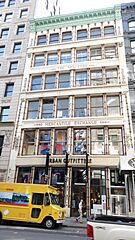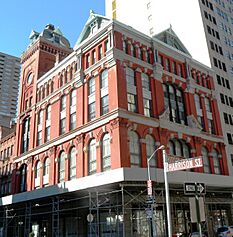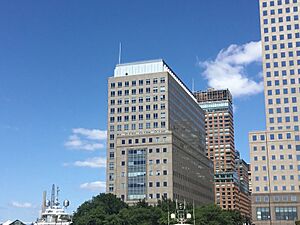New York Mercantile Exchange facts for kids
 |
|
| Subsidiary | |
| Founded | 1882 |
| Headquarters | One North End Avenue Manhattan, New York City, New York 10285 United States |
| Parent | CME Group |
The New York Mercantile Exchange (NYMEX) is a special marketplace where people buy and sell things like oil, natural gas, and metals. It's like an auction house, but for future deliveries of these important items. NYMEX is owned by a company called CME Group, which is based in Chicago. You can find NYMEX in Manhattan, New York City, at One North End Avenue in a place called Brookfield Place.
NYMEX has two main parts: the New York Mercantile Exchange itself and another part called Commodity Exchange, Inc (COMEX). These two used to be separate companies. NYMEX started a long time ago, in 1882. For many years, it was owned by the people who traded there.
Later, in 2006, NYMEX became a public company, meaning its shares could be bought and sold on the New York Stock Exchange. Then, in 2008, CME Group bought NYMEX Holdings, Inc. for a lot of money. Now, both NYMEX and COMEX are part of the CME Group. Other parts of CME Group include the Chicago Mercantile Exchange and the Chicago Board of Trade.
The New York Mercantile Exchange handles billions of dollars' worth of important goods. These include oil, other types of energy, and metals. People buy and sell these items for delivery in the future, either on the trading floor or through computer systems. The prices set at NYMEX help decide how much people around the world pay for these goods.
The trading floor at NYMEX is watched over by the Commodity Futures Trading Commission. This is a special government agency in the United States. Companies that want to trade on NYMEX send their own brokers to the floor. These brokers make the deals, and NYMEX employees simply record what happens.
For a long time, NYMEX used a system called open outcry. This meant traders would shout and use special hand signals on the trading floor to make deals. However, most trading became electronic by 2006. NYMEX kept a small area for open outcry until December 30, 2016. After that, the open outcry pit closed permanently because fewer people were using it.
Contents
How NYMEX Started
Commodity exchanges like NYMEX began in the mid-1800s. Business people wanted organized places to buy and sell goods more easily. These places helped buyers and sellers agree on quality, standards, and business rules. By the late 1800s, there were many such marketplaces near ports and railroad stations.
In 1872, some Manhattan dairy merchants created the Butter and Cheese Exchange of New York. They wanted to bring order to their industry. Soon, egg trading was added, and the name changed to the Butter, Cheese, and Egg Exchange. In 1882, it became the New York Mercantile Exchange. This new name allowed them to trade dried fruits, canned goods, and poultry.
As big warehouses were built in cities like New York and Chicago, smaller exchanges disappeared. This meant more business for larger exchanges like NYMEX. In 1933, COMEX was formed by combining four smaller exchanges. For many years, COMEX, NYMEX, and other exchanges shared a trading floor in 4 World Trade Center.
What NYMEX Traded
For many years, NYMEX traders did a lot of business with Maine's potato crop. There were some problems in this market, including a big incident in the 1970s. This event caused a lot of trouble and damaged NYMEX's reputation. Because of this, NYMEX was stopped from trading potato futures. It was also not allowed to start trading in any new areas. This was a big blow to NYMEX.
After the potato trading ban, NYMEX's future was uncertain. Most of its business had been in potatoes. Without a good product to trade, it was hard for traders to make money. Then, a new chairman, Michel Marks, and an economist, Arnold Safer, found a solution. They decided to improve an old contract for heating oil.
When the government allowed more freedom in heating oil trading, this contract had a chance to become popular. A new futures contract was carefully created, and trading began in 1978. Some of the first people to use NYMEX heating oil deliveries were small suppliers in the Northern United States.
NYMEX's new business in energy trading challenged big oil companies and groups like OPEC. These groups had traditionally controlled oil prices. NYMEX created an "open market" where prices for heating oil, and later crude oil, gasoline, and natural gas, were clear to everyone. NYMEX's oil futures contracts were set up for the delivery of West Texas Intermediate crude oil to a place called Cushing, Oklahoma.
How NYMEX Grew
The energy trading business grew very quickly, and NYMEX became very successful. The open outcry trading floor was a busy place with traders shouting and using special pit cards. It became a place where many people could become wealthy.
COMEX, which shared the 4 World Trade Center building with NYMEX, used to think of NYMEX as smaller and less important. But with NYMEX's energy trading boom, it became much larger and richer than COMEX. On August 3, 1994, NYMEX and COMEX officially joined together under the NYMEX name.
By the late 1990s, there were too many people working on the NYMEX floor for the space available. So, in 1997, NYMEX moved to a new building in Manhattan. This building was part of a group of buildings called the World Financial Center. In 2014, these buildings were renamed Brookfield Place.
Recent History
September 11, 2001, Attacks
The NYMEX building was near the World Trade Center. When the terrorist attacks happened on September 11, 2001, the original headquarters of another exchange, NYBOT, were destroyed. Several NYMEX people were lost in the tragedy, even though the new NYMEX building itself was mostly unharmed. Despite the damage in the area, NYMEX quickly got its trading operations working again.
NYMEX had a close relationship with many organizations in the World Trade Center area. After the attacks, NYMEX built a special backup trading facility outside of New York City. This facility cost $12 million and had 700 trading booths, 2,000 telephones, and a backup computer system. This was in case of another attack or natural disaster in Lower Manhattan.
Electronic Trading
For a while, NYMEX had almost complete control over "open market" oil futures trading. However, in the early 2000s, electronic trading systems started to take business away from open outcry markets like NYMEX. Companies like Enron and Intercontinental Exchange (ICE) began offering online energy trading. ICE even started trading oil contracts that were very similar to NYMEX's, quickly gaining market share.
The traders who worked in the open outcry pits at NYMEX were usually against electronic trading. They worried it would reduce their income and change their way of life. But the leaders at NYMEX felt that electronic trading was necessary to keep the exchange competitive. In 2006, NYMEX teamed up with the Chicago Mercantile Exchange to use their electronic trading system called Globex. As a result, many trading pits became empty as traders left. Banks, hedge funds, and large oil companies started trading directly on computer screens instead of calling the pits.
During this time, NYMEX also helped create the Dubai Mercantile Exchange in the United Arab Emirates. This story was told in the book Rigged by Ben Mezrich.
Changes and Sale
The leaders of NYMEX eventually decided to sell off parts of the company. In 2006, NYMEX offered its shares to the public for the first time (an initial public offering or IPO). This made the executives and members who owned seats on the exchange much richer. However, many pit traders who only leased their seats did not benefit as much.
Other parts of NYMEX were sold to private investors and the Chicago Mercantile Exchange. The CME Group gained ownership of the physical buildings and began removing the NYMEX name and logo from various items. They even closed the NYMEX museum. NYMEX eventually became mostly a brand name used by CME. By 2011, open outcry trading at NYMEX was mostly limited to a small number of people trading options.
How Trading Happens
- Pit (open outcry)
- Electronic trading (Globex)
What NYMEX Trades
- NYMEX Division
- COMEX Division
See also
 In Spanish: New York Mercantile Exchange para niños
In Spanish: New York Mercantile Exchange para niños
- Commodity Exchange Act
- Energy law
- New York Cotton Exchange
- List of futures exchanges
- List of traded commodities
- RBOB - (Reformulated Blendstock for Oxygenate Blending)




